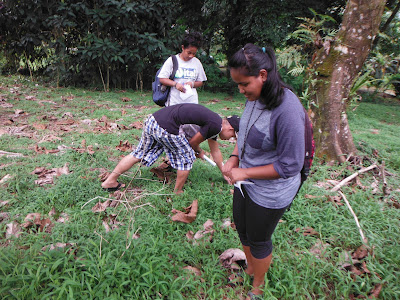Invasive species walk and seek
This term I took a different approach in ethnobotany to what had been a day devoted to finding and pulling Clidemia hirta. The development of the football pitch had reduced the C. hirta in the forest across the road. A seek and find spring 2015 found only isolated clumps deep in the swampier sections of the forest. I shifted in the spring to trying to find both Clidemia hirta and Melastoma malabathricum var. marianum.
The spring 2015 walk had difficulty finding M. malabathricum. The walk stretched out and led to identifying many of the other invasive species along the way. This fall I built on that by providing an invasive species checklist handout (OpenDocument format file).
Dissotis rotundifolia. Melastomataceae. Also known as Spanish shawl, Pinklady, trailing dissotis. May also be known as trailing Tibouchina. A member of Melastomaceae, also known as Melastomataceae. Other members include Clidemia hirta and Melastoma malabathricum var. marianum.
I began with a trip over to the old ethnobotanic garden. On the way I covered Sphagneticola trilobata and Mimosa pudica. After a stop at Ipomoea carnea I spoke about the potentially invasive nature of Clerodendrum inerme (ilau). The usefulness of this medicinal plant and the lack of aggressive spreading on Pohnpei means that C. inerme is not considered invasive. Clerodendrum quadriloculare, however, is invasive. We walking into the election day road to see the understory to Clerodendrum quadriloculare. I showed that only Clidemia hirta could survive under C. quadriloculare. I also walked the class down to see Ipomoea mauritiana.
I walked the class back towards the football pitch, stopping to show them Dissotis rotundifolia. Then I headed into the pitch and found Melastoma malabathricum var. marianum (pisetikimei) with C. hirta intermingled. D. rotundifolia was underneath both. I was ecstatic. Out there we also say Chromolaena odorata and biocontrols.
The football pitch is a moonscape with invasives such as the fuelwood tree Falcataria moluccana (tuhken kerosin).
During the walk I also noted the presence of Senna alata and Colocassia escuelenta.
Possible Acacia spp. While A. auruculiformis is common, A. linearis was present in Paies ten years ago.
Erica amidst Ischaemum polystachum
The spring 2015 walk had difficulty finding M. malabathricum. The walk stretched out and led to identifying many of the other invasive species along the way. This fall I built on that by providing an invasive species checklist handout (OpenDocument format file).
Dissotis rotundifolia. Melastomataceae. Also known as Spanish shawl, Pinklady, trailing dissotis. May also be known as trailing Tibouchina. A member of Melastomaceae, also known as Melastomataceae. Other members include Clidemia hirta and Melastoma malabathricum var. marianum.
Shannon, Aiesha-Lane,
Sylvia
I walked the class back towards the football pitch, stopping to show them Dissotis rotundifolia. Then I headed into the pitch and found Melastoma malabathricum var. marianum (pisetikimei) with C. hirta intermingled. D. rotundifolia was underneath both. I was ecstatic. Out there we also say Chromolaena odorata and biocontrols.
Annalissa
During the walk I also noted the presence of Senna alata and Colocassia escuelenta.
Mera
Melastoma malabathricum var. marianum
Possible Acacia spp. While A. auruculiformis is common, A. linearis was present in Paies ten years ago.













Comments
Post a Comment